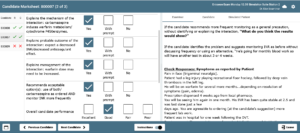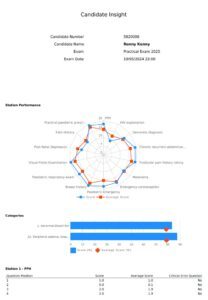- +44 (0)1223 851703
- info@speedwellsoftware.com
Principles of an OSCE
The OSCE – an Objective Structured Clinical Examination – is widely used across all disciplines in medical education. Often regarded as the gold standard in assessing clinical competence, they evaluate students’ ability to apply practical skills and demonstrate key competencies essential for clinical practice.
OSCEs usually consist of a circuit of stations, each simulating a different medical scenario. Candidates rotate through these timed stations, performing tasks while examiners observe them. By definition, they should offer a structured and objective method of fairly and consistently assessing candidates, regardless of the examiner or station.
Key to maintaining this standardisation is the use of clearly defined OSCE marking criteria. These help remove ambiguity and guide examiners in assessing candidate performance against consistent, established benchmarks. In some cases, it’s shared with students in advance to support their preparation. For example, you can view the Nursing OSCE Marking Criteria here.
Discussions around OSCEs often highlight student preparation and performance, yet they frequently overlook the operational demands placed on institutions. Managing consistent marking, reducing examiner error, and delivering meaningful feedback at scale remains a challenge. This is particularly the case where institutions rely on in-house or generic digital solutions which are not purpose-built for the task.
However, there is an answer – this post examines how exam software such as Speedwell’s eSystem offers significant benefits for both institutions and candidates.
Challenges with non-specialist OSCE solutions
While many institutions have moved beyond paper OSCEs, the systems replacing them are often improvised or pieced together using generic digital tools. These include spreadsheets, shared folders, Google Forms, and other basic platforms. None of which were designed with the complexity and real-time demands of OSCEs in mind.
These workarounds come with their own challenges. For example, version control and coordination issues can lead to errors or lost data, especially when managing multiple examiners and stations. Manual processes for calculating scores or collating results are time-consuming and error-prone. Switching between documents (marking criteria and mark sheets) can disrupt the examiner’s workflow and increase the likelihood of oversight. Additionally, the lack of standardised formats often results in inconsistent feedback., This makes it harder to compare or interpret results fairly. All of these factors can compromise the accuracy and integrity of the assessment process.
Whilst they may offer some improvements over paper methods, these processes are still highly manual. Analysing performance and delivering meaningful feedback beyond a basic score or pass/fail remains labour-intensive and impractical at scale. As a result, many institutions struggle to provide detailed OSCE feedback to students. Or track performance trends across stations, cohorts, or learning outcomes in a meaningful way.
To address these issues, increasingly, institutions are turning to exam software that has been purpose-built to manage and streamline the OSCE process.
Exam Software transforms the OSCE marking process
A specialist OSCE platform like Speedwell’s eSystem transforms how OSCEs are delivered and marked. It is specifically designed for the needs of clinical assessments, bringing structure, consistency, and reliability to every stage.
The OSCE marking criteria is clearly displayed alongside the mark sheet so examiners have everything they need at hand. With the eSystem, you can configure it so examiners can’t move to another candidate if a marksheet is incomplete. This removes the potential for missed marks. Furthermore, for the OSCE feedback fields, it’s possible to configure them to a minimum number of characters. Meaning examiners must enter a minimum level of feedback. These are challenges that paper, spreadsheets or shared documents simply aren’t equipped to handle reliably at scale.
With the eSystem, assessors can monitor exams in real time, providing assurance that everything is progressing as it should. Any issues that arise can be dealt with swiftly. Understandably, there may be concerns about wifi availability or reliability. However, there are safeguards in place which ensure a seamless exam experience. There are options to run the exam entirely offline via the OSCE App or run it online. With the online option, should the internet fail briefly, the exam will dynamically switch to offline mode and continue without interruption. It reconnects once the connection is restored, offering peace of mind.
Finally, its intuitive, easy-to-use format means that even examiners with limited IT experience can navigate and use the mark sheets.
Example of an OSCE Mark Sheet:

However, where the eSystem really adds value for both institutions and candidates is in how it enhances OSCE results and feedback.
Transforming results into meaningful OSCE feedback
As outlined earlier, with many in-house systems, providing detailed OSCE feedback is a manual, time-consuming task. A task that often isn’t feasible at scale. However, this is where specialist OSCE exam software comes into its own. With Speedwell’s eSystem, you can instantly generate insightful reports that draw directly from assessment data. You can view performance across stations, spot variations between assessors, and identify areas where the marking scheme or station design might need adjustment. This level of analysis helps improve future OSCEs and ensures fairness remains central to the process.
It’s easy to quickly generate personalised feedback reports for candidates. You define exactly what is included, but they can include detailed breakdowns of performance by station, subject groups, individual questions, and examiner comments.
The reports present the data in a clear, easy-to-interpret format using tables and graphs. Notably, it also enables candidates to see how their performance compares to their peers or against averages. This adds valuable context to help them better understand their results and identify areas for improvement.
Example OSCE Feedback Report:

A practical solution for modern OSCEs
While many institutions have taken steps to digitise their OSCEs — offering improvements over traditional paper-based processes — the tools in use often fall short
The inherent complexity of OSCEs, combined with an increasing demand for high-quality feedback from candidates, highlights the need for a more robust approach. Purpose-built exam software offers a practical resolution. It brings greater structure and reliability to the marking process, while also enabling the delivery of consistent, data-driven feedback at scale.
By adopting specialist OSCE software, institutions can make their assessments more efficient, fair, and consistent. This ultimately results in better outcomes and more meaningful feedback for learners.










